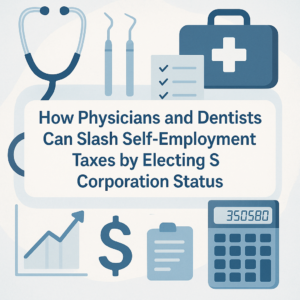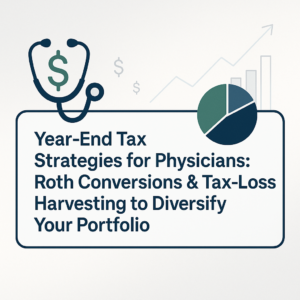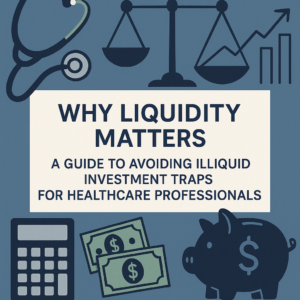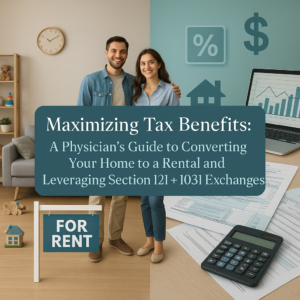Maximizing Your IRA Contributions for a Tax-Efficient Future
As a young healthcare professional, you’ve invested years into your education and training. Now, with a rewarding career ahead, it’s essential to invest time in planning for your financial future. Retirement might seem distant, but the choices you make today can significantly impact your financial well-being tomorrow. This comprehensive guide will help physicians, dentists, pharmacists, physical therapists, psychologists, and other high-income healthcare workers navigate the complexities of Individual Retirement Accounts (IRAs) to optimize retirement savings and achieve tax efficiency.
Understanding the Retirement Landscape for Healthcare Professionals
The Financial Realities of High-Income Earners
Healthcare professionals often find themselves in higher tax brackets due to substantial incomes. While a higher salary is advantageous, it also means potential obstacles in accessing certain retirement savings tools and strategies designed for individuals with lower incomes. Understanding these limitations is the first step in crafting a retirement plan that aligns with your financial situation.
The Importance of Early and Strategic Planning
Starting retirement planning early in your career allows you to take full advantage of compound interest and tax-advantaged accounts. Strategic planning is especially crucial for high-income earners who may face income thresholds that limit or prevent contributions to certain retirement accounts, such as Roth IRAs.
Traditional IRA vs. Roth IRA: What High-Income Earners Need to Know
Traditional IRA
A Traditional IRA allows you to contribute pre-tax dollars, which can reduce your taxable income for the year of the contribution. The investments grow tax-deferred, meaning you won’t pay taxes on the earnings until you withdraw the funds in retirement. However, for high-income earners who are covered by a workplace retirement plan, the ability to deduct Traditional IRA contributions on your tax return phases out at higher income levels.
Roth IRA
With a Roth IRA, contributions are made with after-tax dollars, so there’s no immediate tax benefit. However, the earnings grow tax-free, and qualified withdrawals in retirement are also tax-free. This can be highly advantageous, but direct contributions to a Roth IRA are limited or prohibited for individuals with income exceeding certain limits.
Income Limits and Their Impact on IRA Contributions
Understanding IRS Income Limits
The IRS sets annual income limits that affect eligibility for deducting Traditional IRA contributions and making Roth IRA contributions. For 2024, single filers with a modified adjusted gross income (MAGI) above $161,000 and married couples filing jointly with a MAGI above $240,000 are ineligible to contribute directly to a Roth IRA.
Phase-Out Ranges
If your income falls within certain ranges, your ability to contribute is phased out. For example, in 2024, married couples filing jointly with a MAGI between $230,000 and $240,000 can make reduced Roth IRA contributions.
Strategies for High-Income Healthcare Professionals
1. Making Non-Deductible Contributions to a Traditional IRA
Even if you’re above the income limits for deducting Traditional IRA contributions, you can still contribute to a Traditional IRA on a non-deductible basis. While you won’t get an immediate tax deduction, your investments will grow tax-deferred, and you’ll only pay taxes on the earnings upon withdrawal.
Filing Form 8606
When making non-deductible contributions, it’s crucial to file IRS Form 8606 with your tax return each year. This form tracks your basis (after-tax contributions) in the IRA, ensuring you don’t pay taxes again on the amounts you’ve already paid taxes on when you withdraw the funds in retirement.
Advantages
- Continued Tax-Deferred Growth: Your investments can grow without the drag of annual taxes.
- Slight Tax Benefit Upon Withdrawal: Since you contributed after-tax dollars, a portion of your withdrawals will be tax-free, reducing your overall tax liability in retirement.
2. Utilizing the Backdoor Roth IRA Strategy
The Backdoor Roth IRA allows high-income earners to circumvent the income limits by converting a Traditional IRA into a Roth IRA.
How It Works
- Step 1: Contribute to a Traditional IRA (non-deductible, if over the income limit).
- Step 2: Convert the Traditional IRA to a Roth IRA. Since you’ve already paid taxes on the contributions, you’re only taxed on any earnings during the short period before the conversion.
Challenges with Existing Pre-Tax IRA Balances
The Pro Rata Rule requires you to consider all your Traditional, SEP, and SIMPLE IRA balances when calculating taxes owed on a conversion. If you have significant pre-tax IRA balances, a portion of your conversion will be taxable, potentially diminishing the benefits of the Backdoor Roth strategy.
Possible Solutions
- Rollover to Employer Plan: Transfer pre-tax IRA balances into a 401(k) or similar employer-sponsored plan, if allowed, to minimize pre-tax IRA balances.
- Accept Partial Taxation: Calculate whether the benefits of the Roth conversion outweigh the taxes due on the conversion.
3. Planning for Roth Conversions in Lower-Income Years
Roth conversions involve moving funds from a Traditional IRA to a Roth IRA, paying taxes on the converted amount now to enjoy tax-free withdrawals later. This strategy can be particularly effective in years when your income is lower, such as during a sabbatical, residency, or fellowship.
Benefits
- Tax Diversification: Having both pre-tax and after-tax retirement accounts provides flexibility in managing taxable income during retirement.
- Future Tax Savings: If you expect to be in a higher tax bracket in retirement, paying taxes now at a lower rate can be advantageous.
Maximizing Employer-Sponsored Retirement Plans
401(k) and 403(b) Plans
Max out contributions to employer-sponsored retirement plans. For 2024, the contribution limit is $23,000, with an additional $7,000 catch-up contribution if you’re 50 or older. Contributions reduce your taxable income and investments grow tax-deferred.
SEP IRA for Self-Employed Professionals
If you have self-employment income, consider a SEP IRA, which allows for higher contribution limits based on your income. Contributions are tax-deductible, and the plan is relatively easy to set up and manage.
Timing of Contributions
For SEP IRAs, you can make contributions up until the tax filing deadline, including extensions. This flexibility allows you to adjust contributions based on actual income for the year.
Conclusion
Retirement planning for high-income healthcare professionals involves navigating complex tax rules and maximizing available strategies to enhance your financial future. By understanding your options and implementing strategic contributions and conversions, you can build a robust, tax-efficient retirement portfolio. Start planning today to secure the financial security you deserve after a career dedicated to caring for others.






